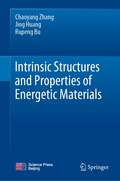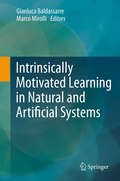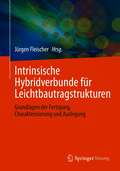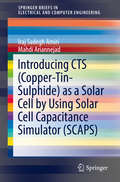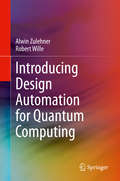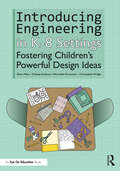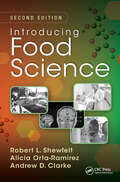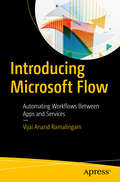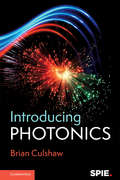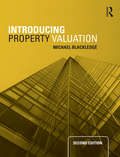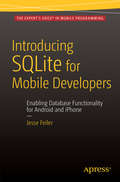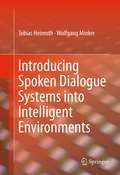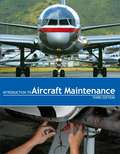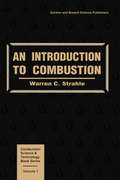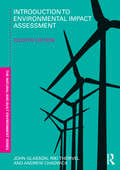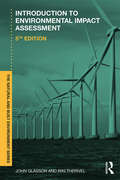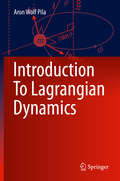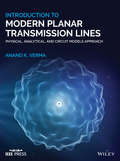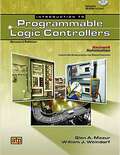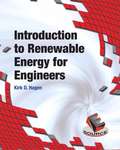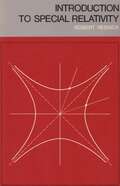- Table View
- List View
Intrinsic Structures and Properties of Energetic Materials
by Jing Huang Chaoyang Zhang Rupeng BuThis book highlights the intrinsic structures of all kinds of energetic compounds and some structure–property relationships therein. Energetic materials are a class of energy materials that can transiently release a large amount of gases and heat by self-redox after stimulated and usually refer to explosives, propellants and pyrotechnics. Nowadays, in combination with various theories and simulation-aided material design technologies, many new kinds of energetic materials like energetic extended solids, energetic ionic salts, energetic metal organic frames, energetic co-crystals and energetic perovskites have been created, in addition to traditional energetic molecular crystals. It is somewhat dazzling, and an issue of how we can understand these new types of energetic materials is raised. In the past about 20 years, we were immersed in the computational energetic materials. By means of defining a concept of intrinsic structures of energetic materials, which refers to the crystal packing structure of energetic materials, as well as molecule for molecular solid specially, the microscopic structures have been mostly clarified, and related with many macroscopic properties and performances, with molecular simulations. This book presents our understanding about it. Thereby, a simply and new way to readily understand energetic materials is expected to be paved, based on this book. It contains energetic molecular crystals, energetic ionic crystals, energetic atomic crystals, energetic metallic crystals and energetic mixed-type crystals and the substructures closest to crystal packing. Meanwhile, the common intermolecular interactions in energetic crystals will be introduced. In addition, theoretical and simulation methods for treating the intrinsic structures will be briefed, as they are the main tools to reveal the molecules and crystals. Besides, the polymorphism as a level of intrinsic structures will be briefly discussed. In the final of this book, we introduce the crystal engineering of energetic materials. This book features the first proposal of intrinsic structure and crystal engineering of energetic materials and the understanding of the properties and performances of energetic materials by maintaining a concept that structure determines property. It helps to promote the rationality in creating new energetic materials, rather than increase experience.
Intrinsically Motivated Learning in Natural and Artificial Systems
by Marco Mirolli Gianluca BaldassarreIt has become clear to researchers in robotics and adaptive behaviour that current approaches are yielding systems with limited autonomy and capacity for self-improvement. To learn autonomously and in a cumulative fashion is one of the hallmarks of intelligence, and we know that higher mammals engage in exploratory activities that are not directed to pursue goals of immediate relevance for survival and reproduction but are instead driven by intrinsic motivations such as curiosity, interest in novel stimuli or surprising events, and interest in learning new behaviours. The adaptive value of such intrinsically motivated activities lies in the fact that they allow the cumulative acquisition of knowledge and skills that can be used later to accomplish fitness-enhancing goals. Intrinsic motivations continue during adulthood, and in humans they underlie lifelong learning, artistic creativity, and scientific discovery, while they are also the basis for processes that strongly affect human well-being, such as the sense of competence, self-determination, and self-esteem. This book has two aims: to present the state of the art in research on intrinsically motivated learning, and to identify the related scientific and technological open challenges and most promising research directions. The book introduces the concept of intrinsic motivation in artificial systems, reviews the relevant literature, offers insights from the neural and behavioural sciences, and presents novel tools for research. The book is organized into six parts: the chapters in Part I give general overviews on the concept of intrinsic motivations, their function, and possible mechanisms for implementing them; Parts II, III, and IV focus on three classes of intrinsic motivation mechanisms, those based on predictors, on novelty, and on competence; Part V discusses mechanisms that are complementary to intrinsic motivations; and Part VI introduces tools and experimental frameworks for investigating intrinsic motivations.The contributing authors are among the pioneers carrying out fundamental work on this topic, drawn from related disciplines such as artificial intelligence, robotics, artificial life, evolution, machine learning, developmental psychology, cognitive science, and neuroscience. The book will be of value to graduate students and academic researchers in these domains, and to engineers engaged with the design of autonomous, adaptive robots. The contributing authors are among the pioneers carrying out fundamental work on this topic, drawn from related disciplines such as artificial intelligence, robotics, artificial life, evolution, machine learning, developmental psychology, cognitive science, and neuroscience. The book will be of value to graduate students and academic researchers in these domains, and to engineers engaged with the design of autonomous, adaptive robots.
Intrinsically Motivated Learning in Natural and Artificial Systems
by Marco Mirolli Gianluca BaldassarreIt has become clear to researchers in robotics and adaptive behaviour that current approaches are yielding systems with limited autonomy and capacity for self-improvement. To learn autonomously and in a cumulative fashion is one of the hallmarks of intelligence, and we know that higher mammals engage in exploratory activities that are not directed to pursue goals of immediate relevance for survival and reproduction but are instead driven by intrinsic motivations such as curiosity, interest in novel stimuli or surprising events, and interest in learning new behaviours. The adaptive value of such intrinsically motivated activities lies in the fact that they allow the cumulative acquisition of knowledge and skills that can be used later to accomplish fitness-enhancing goals. Intrinsic motivations continue during adulthood, and in humans they underlie lifelong learning, artistic creativity, and scientific discovery, while they are also the basis for processes that strongly affect human well-being, such as the sense of competence, self-determination, and self-esteem.This book has two aims: to present the state of the art in research on intrinsically motivated learning, and to identify the related scientific and technological open challenges and most promising research directions. The book introduces the concept of intrinsic motivation in artificial systems, reviews the relevant literature, offers insights from the neural and behavioural sciences, and presents novel tools for research. The book is organized into six parts: the chapters in Part I give general overviews on the concept of intrinsic motivations, their function, and possible mechanisms for implementing them; Parts II, III, and IV focus on three classes of intrinsic motivation mechanisms, those based on predictors, on novelty, and on competence; Part V discusses mechanisms that are complementary to intrinsic motivations; and Part VI introduces tools and experimental frameworks for investigating intrinsic motivations.The contributing authors are among the pioneers carrying out fundamental work on this topic, drawn from related disciplines such as artificial intelligence, robotics, artificial life, evolution, machine learning, developmental psychology, cognitive science, and neuroscience. The book will be of value to graduate students and academic researchers in these domains, and to engineers engaged with the design of autonomous, adaptive robots.The contributing authors are among the pioneers carrying out fundamental work on this topic, drawn from related disciplines such as artificial intelligence, robotics, artificial life, evolution, machine learning, developmental psychology, cognitive science, and neuroscience. The book will be of value to graduate students and academic researchers in these domains, and to engineers engaged with the design of autonomous, adaptive robots.
Intrinsische Hybridverbunde für Leichtbautragstrukturen: Grundlagen der Fertigung, Charakterisierung und Auslegung
by Jürgen FleischerDer Einsatz von Leichtbautragstrukturen bietet heutzutage die Möglichkeit eine signifikante Gewichtsreduzierung zu realisieren. Bei der Gestaltung dieser Leichtbautragstrukturen müssen, je nach Anwendungsfall, eine Vielzahl von Anforderungen berücksichtigt werden. Die komplette Substitution eines Werkstoffes ist für die konsequente Nutzung des Leichtbaupotentials nicht immer zielführend. Eine optimale Gesamtstruktur besteht aus einer hybriden Werkstoffkombination, dem sogenannten Multi-Material-Design. Der Ansatz der Hybridisierung von Strukturkomponenten rückt somit immer stärker in den Vordergrund und kann grundsätzlich nach zwei unterschiedlichen Methoden erfolgen. Zum einen können zwei Bauteile aus Faserverbundkunststoff und Metall durch nachgeschaltete Fügeprozesse, wie beispielsweise Nieten, Schrauben oder Kleben, gefügt werden. Nachteil dieses Ansatzes ist neben dem Aufwand für den Fügeprozess die zusätzliche Masse, durch die das Leichtbaupotential nicht vollkommen ausgeschöpft werden kann. Zum anderen besteht die Möglichkeit der Herstellung des Hybridverbunds in einem einstufigen Prozess, wobei die Verbindung der verschiedenen Materialien im Ur- oder Umformprozess ohne einen nachfolgenden Fügeschritt erfolgt. Das entstehende Bauteil dieses einstufigen Prozesses wird als intrinsisches Hybrid bezeichnet. Aufgrund der intrinsischen Hybridisierung entstehen neue Gestaltungsmöglichkeiten und produktionstechnische Vorteile, aber auch Herausforderungen in Bezug auf die Prüfung, Simulation und Herstellung. Im Rahmen des Schwerpunktprogramms 1712 der Deutschen Forschungsgemeinschaft wurde hierzu auf den Fachgebieten Produktionstechnik, Mechanik und Werkstoffwissenschaften intensiv Forschungsarbeit geleistet.
Introducing CTS (SpringerBriefs in Electrical and Computer Engineering)
by Iraj Sadegh Amiri Mahdi AriannejadThis book discusses the enhancement of efficiency in currently used solar cells. The authors have characterized different structures of the solar cell system to optimize system parameters, particularly the performance of the Copper-Tin-Sulphide solar cell using Solar Cell Capacitance Simulator (SCAPS). This research can help scientist to overcome the current limitations and build up new designs of the system with higher efficiency and greater functionality. The authors have investigated the corresponding samples from various viewpoints, including structural (crystallinity, composition and surface morphology), optical (UV–vis–near-IR transmittance/reflectance spectra) and electrical resistivity properties. Describes investigations on Cu2SnS3 solar cells and prospective low cost absorber layer of thin film solar cells;Discusses the potential device structure of Copper-Tin-Sulphide based on thin film technologies;Explains solar cell structure optimization to perform a higher conversion efficiency of Copper-Tin-Sulphide.
Introducing Design Automation for Quantum Computing
by Robert Wille Alwin ZulehnerThis book offers readers an easy introduction into quantum computing as well as into the design for corresponding devices. The authors cover several design tasks which are important for quantum computing and introduce corresponding solutions. A special feature of the book is that those tasks and solutions are explicitly discussed from a design automation perspective, i.e., utilizing clever algorithms and data structures which have been developed by the design automation community for conventional logic (i.e., for electronic devices and systems) and are now applied for this new technology. By this, relevant design tasks can be conducted in a much more efficient fashion than before – leading to improvements of several orders of magnitude (with respect to runtime and other design objectives).Describes the current state of the art for designing quantum circuits, for simulating them, and for mapping them to real hardware;Provides a first comprehensive introduction into design automation for quantum computing that tackles practically relevant tasks;Targets the quantum computing community as well as the design automation community, showing both perspectives to quantum computing, and what impressive improvements are possible when combining the knowledge of both communities.
Introducing Engineering in K-8 Settings: Fostering Children's Powerful Design Ideas
by Christopher Wright Elissa Milto Chelsea Andrews Merredith PortsmoreIntroducing Engineering to K-8 Students will provide you with the tools you need to incorporate engineering design into your classroom. Rather than prescribing a specific curriculum to follow, this book will help you engage your students with hands-on, open-ended engineering design problems that can be easily integrated into your existing classroom setup.Beginning with the basics of K-8 engineering, and advancing to topics such as integrating engineering with other disciplines, documentation, and assessments, the chapters provide a how-to on creating open-ended engineering activities, design tasks, and projects that are reflective of the academic, social, emotional, developmental, and community goals of your students. An additional focus is on ways to adapt these pedagogical approaches to meet the needs of all students, representative of racially, ethnically, socioeconomically, and gender diverse populations and students who receive special education services. Case studies and practical implementation strategies are presented alongside more than fifteen lesson plans, with tips on how to modify the tasks presented in the book to work with your classroom and students. This user-centered approach will also help you create your own engineering lessons that meet your individual classroom objectives and interests, and be able to recognize and classify your students’ engineering behaviors to support them in enacting their ideas.No matter your experience or comfort level, this book will be an invaluable resource for elementary and middle school science and technology teachers at all career stages who are looking to introduce engineering design to their students.Additional classroom resources can be found online at introducingengineering.org.
Introducing Food Science
by Robert L. Shewfelt Andrew D. Clarke Alicia Orta-RamirezWritten as an introductory food science textbook that excites students and fosters learning, the first edition of Introducing Food Science broke new ground. With an easy-to-read format and innovative sections such as Looking Back, Remember This!, and Looking Ahead, it quickly became popular with students and professors alike. This newly r
Introducing Microsoft Flow: Automating Workflows Between Apps And Services
by Vijai Anand RamalingamUse Microsoft Flow in your business to improve productivity through automation with this step-by-step introductory text from a Microsoft Flow expert. You’ll see the prerequisites to get started with this cloud-based service, including how to create a flow and how to use different connectors. Introducing Microsoft Flow takes you through connecting with SharePoint, creating approval flows, and using mobile apps. This vital information gives you a head-start when planning your Microsoft Flow implementation.The second half of the book continues with managing connections and gateways, where you’ll cover the configuration, creation, and deletion of connectors and how to connect to a data gateway. The final topic is Flow administration and techniques to manage the environment.After reading this book, you will be able to create and manage Flow from desktop, laptop, or mobile devices and connect with multiple services such as SharePoint, Twitter, Facebook, and other networking sites.What You Will LearnCreate flows from built-in and blank templates Manage flows, connections, and gatewaysCreate approvals, connect with multiple services, and use mobile appsWho This Book Is ForAdministrators and those who are interested in creating automated workflows using templates and connecting with multiple services without writing a single line of code.
Introducing Photonics
by Brian CulshawThe essential guide for anyone wanting a quick introduction to the fundamental ideas underlying photonics. The author uses his forty years of experience in photonics research and teaching to provide intuitive explanations of key concepts, and demonstrates how these relate to the operation of photonic devices and systems. Readers will gain insight into the nature of light and the ways in which it interacts with materials and structures, and learn how these basic ideas are applied in areas such as optical systems, 3D imaging and astronomy. Carefully designed worked examples and end-of-chapter problems enable students to check their understanding, with full solutions available online. Mathematical treatments are kept as simple as possible, allowing readers to grasp even the most complex of concepts. Clear, concise and accessible, this is the perfect guide for undergraduate students taking a first course in photonics, and anyone in academia or industry wanting to review the fundamentals.
Introducing Property Valuation
by Michael BlackledgeThis new edition of bestselling textbook Introducing Property Valuation provides students with a comprehensive introduction to the concepts and methods of valuing real estate, helping them to progress successfully from basic principles to a more sophisticated understanding. Taking a practically oriented rather than purely theoretical approach, the textbook equips readers with the skills to undertake their own valuation calculations. Fully updated to reflect recent developments in regulation and practice, experienced tutor and valuer Michael Blackledge demonstrates how the principles can be applied in professional practice in line with the requirements and guidance provided by the International Valuation Standards Council and the Royal Institution of Chartered Surveyors. Online material accompanies the new edition with Q&As and pre-programmed excel spreadsheets enabling students to prepare their own calculations. The five traditional methods of valuation are outlined and the practical applications of the two main approaches, the comparison and investment methods, are fully explored. The use of discounted cash flow and quarterly in advance calculations, topics which are not always adequately covered elsewhere, are also explained. Accessibly written with a full range of worked examples, case studies, clear chapter summaries and extensive further reading suggestions, this book is essential for any student of real estate and its valuation.
Introducing Robotic Process Automation to Your Organization: A Guide for Business Leaders
by Robert Fantina Andriy Storozhuk Kamal GoyalFor your robotic process automation (RPA) program to be successful, you need to follow a general framework and governance model. This book covers, in detail, what they should look like and how to adapt them to your organization.Introducing Robotic Process Automation to Your Organization is structured to enable you, a novice to RPA, to successfully implement an RPA program at your company. RPA is rapidly growing in use, but is only starting to be taught at a university level. Many mid-level managers will be tasked with introducing an RPA program at their organizations as senior management learns of its efficacy, but will be unfamiliar with how to do so. This book provides you with the skills and information you need to make an informed decision. For decades, there has been much discussion about the fast pace of technology, the rapidly changing technology environment, and the need for companies to be on the cutting edge to remain competitive or even relevant. In this ever-changing environment, there is a need to know what can be done in terms of current processes, here and now, that will increase efficiency, benefit customers, and improve profitability. One option is RPA.This book includes information to assist you in getting the required buy-in and identifying the first few processes for automation. A structure for identifying opportunities on an ongoing basis is detailed, along with concepts that must be considered for solution design and deployment. Throughout the book there are several "pause and consider" statements to help you think about how principles pertain to your organization. Additionally, there are tips included that offer short, concrete suggestions on how to help implement the particular step being discussed.What You Will LearnKnow the benefits of robotic process automation (RPA)Understand the limitations of RPAAsk the right questions to determine whether a process is a good candidate for automationObtain buy-in from skeptics at the senior and middle manager levels, and from line workersBe familiar with the structure required for successWho This Book is ForMiddle managers who have either identified the need for robotic process automation (RPA) in their organization or have been directed by senior management to explore the possibility of introducing RPA to their organization; managers at all levels who hear about RPA, either through conferences, professional associations, or industry publications, and want to know more; students of business and technology who wish to broaden their understanding of important current trends.
Introducing SQLite for Mobile Developers
by Jesse FeilerThis brief book is a basic introduction to SQLite for iOS and Android developers. The book includes a simple introduction to SQL, a discussion of when to use SQLite, and chapters devoted to using SQLite with the most likely programming languages: Java, PHP, Swift and Objective-C. It then goes through adding simple database functionality to an Android or iOS app and finally a chapter on managing the app's life cycle. What you'll learn What You Will Learn:The basics of SQLite The SQL you need to use SQLite effectively How to integrate database functionality into your mobile app. How to maintain the app Who this book is for This book is for Android or iOS developers who wish to use a lightweight but flexible database for their applications. It assumes mobile development experience but does not assume any database knowledge. Table of Contents 1. Getting Up to Speed with Databases and SQLite 2. Understanding What SQLite Is. . . 3. Working with the relationship model and SQLite 4. Using SQLite basics -- storing and retrieving data 5. Using SQLite features -- What you can do with SELECT statements 6. Using SQLite with PHP 7. Using SQLite with Java (Android) 8. Using SQLite with Swift (iOS/Mac) 9. Using SQLite with Objective-C (iOS/Mac) 10. Exploring the simple database (used in Chapters 10-12) 11. Using the simple database with a website (database example code included) 12. Adding the simple database to an Android app (using android. database. sqlite) 13. Adding the simple database to an iOS app (using Core Data) 14. Considering performance issues 15. Managing the SQLite life cyle
Introducing Spoken Dialogue Systems into Intelligent Environments
by Wolfgang Minker Tobias HeinrothIntroducing Spoken Dialogue Systems into Intelligent Environments outlines the formalisms of a novel knowledge-driven framework for spoken dialogue management and presents the implementation of a model-based Adaptive Spoken Dialogue Manager(ASDM) called OwlSpeak. The authors have identified three stakeholders that potentially influence the behavior of the ASDM: the user, the SDS, and a complex Intelligent Environment (IE) consisting of various devices, services, and task descriptions. The theoretical foundation of a working ontology-based spoken dialogue description framework, the prototype implementation of the ASDM, and the evaluation activities that are presented as part of this book contribute to the ongoing spoken dialogue research by establishing the fertile ground of model-based adaptive spoken dialogue management. This monograph is ideal for advanced undergraduate students, PhD students, and postdocs as well as academic and industrial researchers and developers in speech and multimodal interactive systems.
Introduction To Aircraft Maintenance
by Avotek ResourcesIntroduction to Aircraft Maintenance, the first textbook in Avotek's AMT Series, introduces the fundamentals of aviation maintenance to the beginning student. Written by a panel of aviation professionals for classroom instruction, this text tackles general curriculum subjects such as mathematics, physics and electricity as they relate to aviation, and it examines maintenance specific topics like aircraft inspections, weight and balance, human factors and documentation. <p><p> The breadth of coverage and the variety of topics included in this book go beyond the minimum requirements for 14 CFR Part 147 schools; they relate to actual applications and situations encountered in aviation maintenance industry.
Introduction To Combustion (Combustion Science And Technology Book Ser. #Vol. 1)
by Warren C. StrahleThis book presents basic information about combustion, mostly in the form of examples. It is a textbook for a one-semester or one-quarter course for juniors or seniors in mechanical, aerospace, chemical, or civil engineering.
Introduction To Engineering Analysis
by Kirk HagenFor use in the first-year engineering course. This text is also suitable for individuals interested in adopting a problem-solving approach to engineering problems. <P><P> The goal of this text is to introduce a general problem-solving approach for the beginning engineering student. Thus, Introduction to Engineering Analysis focuses on how to solve (any) kind of engineering analytical problem in a logical and systematic way. The book helps to prepare the students for such analytically oriented courses as statics, strength of materials, electrical circuits, fluid mechanics, thermodynamics, etc.
Introduction To Environmental Impact Assessment
by Andrew Chadwick John Glasson Riki TherivelIntroduction to Environmental Impact Assessment provides students and practitioners with a clearly structured overview of the subject, as well as critical analysis and support for further studies. Written by three authors with extensive research, training and practical experience in EIA (Environmental Impact Assessment), the book covers the latest EIA legislation, guidance and good practice. This edition updates essential information on: • the evolving nature of EIA• experience of the implementation of the changing EU and UK EIA procedures• best practice in the EIA process• other key issues in the process, explored in an extended case studies section• comparative EIA systems worldwide• development of SEA/SA legislation and practice• prospects for the future of EIA. Although the book’s focus is on the UK and the EU, the principles and techniques it describes are applicable internationally. With colour images and a new modern design, the book provides an essential introduction to EIA for undergraduate and postgraduate students on planning courses, as well as those studying environmental management and policy, environmental sciences, geography and the built environment. Planners, developers, community groups and decision-makers in government and business will also welcome the book as an effective way to get to grips with this important and evolving subject that affects a wide range of development projects.
Introduction To Environmental Impact Assessment: Introduction To Environmental Impact Assessment (Natural and Built Environment Series)
by John Glasson Riki TherivelA comprehensive, clearly structured and readable overview of the subject, Introduction to Environmental Impact Assessment has established itself as the leading introduction to EIA worldwide. This fifth edition is a major update reflecting many significant changes in EIA procedures, process, practice and prospects over the last decade. In particular, it includes: a much more international dimension, drawing on EIA activities worldwide; an up-to-date coverage of the revised EU EIA Directive and its implementation; the associated update of contemporary UK procedures and practice; best practice on evolving methods in the EIA process; a rich array of UK and many international case studies; a new coverage of emerging EIA impact topics, including equality/deprivation; culture; resettlement; climate change; ecosystem services; and risk, resilience and cumulative impacts; an appraisal of some next steps in the EIA process, including a more effective and proportionate EIA; the impact of technological change; the changing interpretation of the project; project implementation, monitoring and adaptive management; and moves towards a more integrated impact assessment. Together, these topics act as a kind of action list for future EIA; the development of SEA legislation and practice in the UK, EU and worldwide; and a set of appendices containing key legislation and an EIS review framework. It is also makes full use of colour illustrations and chapter questions for discussion. Written by two authors with extensive research, training and consultancy experience of EIA, this book brings together the most up-to-date information from many sources. Introduction to Environmental Impact Assessment 5th Edition provides a complete, and critical, introductory text that also supports further studies. Students in undergraduate and postgraduate planning programmes will find it essential as a course text, as will students of environmental management/policy, environmental sciences/studies, geography and built environment. Key stakeholders involved in assessment activities – planners, developers, community groups, pressure groups and decision-makers in government and business – will also welcome this latest edition as a very effective means of getting to grips with the many facets of this important and evolving subject that affects a widening range of development projects.
Introduction To Lagrangian Dynamics
by Aron Wolf PilaThis volume provides a short summary of the essentials of Lagrangian dynamics for practicing engineers and students of physics and engineering. It examines a range of phenomena and techniques in a style that is compact and succinct, while remaining comprehensive. The book provides a review of classical mechanics and coverage of critical topics including holonomic and non-holonomic systems, virtual work, the principle of d’Alembert for dynamical systems, the mathematics of conservative forces, the extended Hamilton’s principle, Lagrange’s equations and Lagrangian dynamics, a systematic procedure for generalized forces, quasi-coordinates, and quasi-velocities, Lagrangian dynamics with quasi-coordinates, Professor Ranjan Vepa’s approach and the Hamiltonian formulation. Adopting a step-by-step approach with examples throughout the book, this ready reference completely develops all of the relevant equations and is ideal for practicing mechanical, aeronautical, and civil engineers, physicists, and graduate/upper-level undergraduate students.Explains in detail the development of the theory behind Lagrangian dynamics in a practical fashion;Discusses virtual work, generalized forces, conservative forces, constraints, Extended Hamilton’s Principle and the Hamiltonian formulation;Presents two different approaches to the quasi-velocity method for non-holonomic constraints;Reinforces concepts presented with illustrative examples;Includes comprehensive coverage of the important topics of classical mechanics.
Introduction To Modern Planar Transmission Lines: Physical, Analytical, and Circuit Models Approach (Wiley - IEEE)
by Anand K. VermaProvides a comprehensive discussion of planar transmission lines and their applications, focusing on physical understanding, analytical approach, and circuit models Planar transmission lines form the core of the modern high-frequency communication, computer, and other related technology. This advanced text gives a complete overview of the technology and acts as a comprehensive tool for radio frequency (RF) engineers that reflects a linear discussion of the subject from fundamentals to more complex arguments. Introduction to Modern Planar Transmission Lines: Physical, Analytical, and Circuit Models Approach begins with a discussion of waves on transmission lines and waves in material medium, including a large number of illustrative examples from published results. After explaining the electrical properties of dielectric media, the book moves on to the details of various transmission lines including waveguide, microstrip line, co-planar waveguide, strip line, slot line, and coupled transmission lines. A number of special and advanced topics are discussed in later chapters, such as fabrication of planar transmission lines, static variational methods for planar transmission lines, multilayer planar transmission lines, spectral domain analysis, resonators, periodic lines and surfaces, and metamaterial realization and circuit models. Emphasizes modeling using physical concepts, circuit-models, closed-form expressions, and full derivation of a large number of expressions Explains advanced mathematical treatment, such as the variation method, conformal mapping method, and SDA Connects each section of the text with forward and backward cross-referencing to aid in personalized self-study Introduction to Modern Planar Transmission Lines is an ideal book for senior undergraduate and graduate students of the subject. It will also appeal to new researchers with the inter-disciplinary background, as well as to engineers and professionals in industries utilizing RF/microwave technologies.
Introduction To Programmable Logic Controllers
by Glenn A. Mazur William J. WeindorfProgrammable logic controllers (PLCs) are increasing in use, and technicians in all fields must be familiar with the fundamentals of installing, programming, and troubleshooting digital and analog PLCs. Introduction to Programmable Logic Controllers is a text/workbook that provides a solid foundation in PLC theory, installation, programming, operation, and troubleshooting. Many large, detailed drawings of commercial and industrial PLC systems are used to support the information in the textbook. Although hands-on training on industrial equipment is the best training method, teaching the use of digital and analog PLCs is often a challenge because of the high costs of equipment. This training package provides several alternatives to these costs. A CD-ROM is included with Introduction to Programmable Logic Controllers and contains information to supplement the textbook.
Introduction To Remote Sensing
by James B. Campbell Randolph H. WynneA leading text for undergraduate- and graduate-level courses, this book introduces widely used forms of remote sensing imagery and their applications in plant sciences, hydrology, earth sciences, and land use analysis. The text provides comprehensive coverage of principal topics and serves as a framework for organizing the vast amount of remote sensing information available on the Web. Including case studies and review questions, the book's four sections and 21 chapters are carefully designed as independent units that instructors can select from as needed for their courses. Illustrations include 29 color plates and over 400 black-and-white figures. New to This Edition *Reflects significant technological and methodological advances. *Chapter on aerial photography now emphasizes digital rather than analog systems. *Updated discussions of accuracy assessment, multitemporal change detection, and digital preprocessing. *Links to recommended online videos and tutorials.
Introduction To Renewable Energy For Engineers
by Kirk D. HagenIntroduction to Renewable Energy for Engineers is intended for beginning engineering students and students in other fields of study who want to learn the fundamental engineering principles of renewable energy. The primary focus of this book is the application of renewable energy to electrical power generation. As each renewable energy technology is explained, the student is shown how to do a basic energy analysis of the corresponding power-generation system. <p><p> Following an introductory chapter that covers the main types of renewable energy, the basics of energy and power calculations, and the fundamental economics of renewable energy systems, the book devotes a separate chapter to each renewable energy type: solar, wind, hydro, geothermal, marine, and biomass.
Introduction To Special Relativity
by Robert ResnickThis book gives an excellent introduction to the theory of special relativity. Professor Resnick presents a fundamental and unified development of the subject with unusually clear discussions of the aspects that usually trouble beginners. He includes, for example, a section on the common sense of relativity. His presentation is lively and interspersed with historical, philosophical and special topics (such as the twin paradox) that will arouse and hold the reader's interest. You'll find many unique features that help you grasp the material, such as worked-out examples, summary tables, thought questions and a wealth of excellent problems. The emphasis throughout the book is physical.
